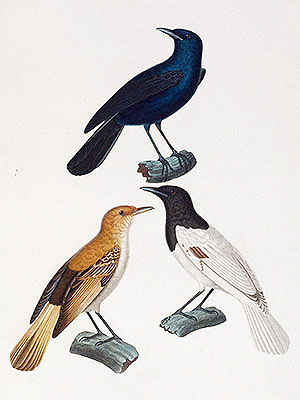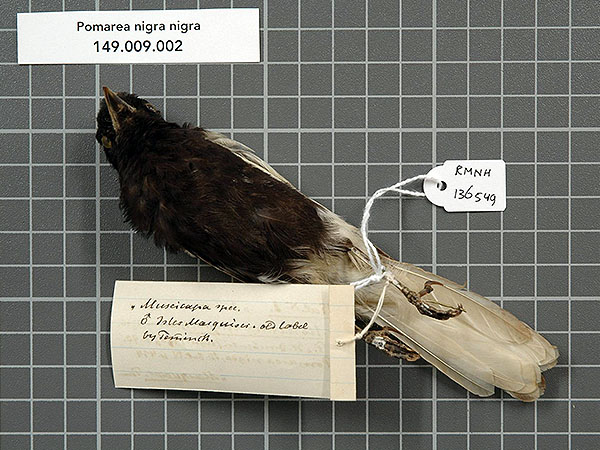The Mangareva Monarch is a very hypothetical species; there may once have been a specimen, collected on the island of Mangareva, Gambier Islands, and there may also have been a drawing of that specimens. Both are now lost, for whatever reasons.
There is now only the description of this bird.:
„Cette pie-grièche est fort voisine du Lanius tabuensis de Latham. Comme elle, on la trouve dans le mer du Sud, et c’est aux îles Gambier qu’elle vit. Cette espèce a les formes courtes et trapues. Elle mesure 14 centimètres. Ses ailes sont presque aussi longues que laqueue; son bec est peu crochu, bien que denté; il est noiràtre ainsi que les tarses; tout le plumage en dessus, les ailes et la queue sont d’un brun olivàtre uniforme; le devant du cou, à partir du menton jusqu’au haut de la poitrine, est olivàtre foncé; tout le dessous du corps, depuis le haut du thorax jusqu’aux couvertures inférieures, est du jaune le plus vif et le plus égal; les plumes tibiales sont brunes, mais cerclées d’une sorte de jarretiere jaune à d’articulation le dedans des ailes est varié de jaune et de blanc, ce qui forme un rebord étroit, blanc dessous du fouet de l’aile; la queue est légèrement échancrée, et le sommet des rectrices présente un point jaune.”
Translation:
“This shrike is very close to Lanius tabuensis [Aplonis tabuensis (Gmelin)] of Latham. Like this, it is found in the South Sea, and it lives in the Gambier Islands. This species has a short, squat form. It measures 14 centimeters. Its wings are almost as long as the tail; the beak is slightly hooked, but dentate; it is black as well as the tarsi; all the plumage above, the wings and the tail are uniformly olive brown; the front of the neck, from the chin to the top of the breast, is dark olive; the whole lower part of the body, from the top of the thorax to the lower coverts, is the liveliest and most even yellow; the tibial feathers are brown, but circled in a sort of yellow, hinged garter, the underside of the wings is varied with yellow and white, forming a narrow, white rim beneath the whip of the wing; the tail is slightly forked, and the top of the rectrices are dotted yellow.”
This description clearly relates to a starling, and in fact, the Mangareva Monarch might well actually have been a Mangareva Starling instead.
I’ll mention the whole story here only because I find it very intriguing.
*********************
References:
[1] R.-P. Lesson: Catalogue descriptif des oiseaux nouveaux, rares ou peu connus, de la collection Abeillé. L’Écho du monde savant et l’Hermès: journal analytique des nouvelles et des cours scientifiques. 1844 pt. 2: 232
*********************
edited: 07.05.2022


